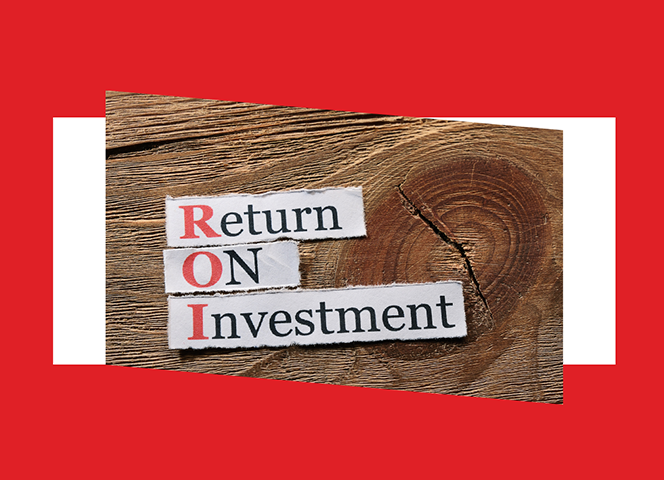Payback is not just for revenge. In business it defines whether a person or process earn their keep. Hence the existence of the all-important Return on Investment (ROI).
When you must convince your COO to invest in Human Resources software – especially if your company views HR technology as a nice-to-have, instead of a need-to-have – ROI becomes your unexpected hero.
ROI highlights your business case: an HR system ultimately delivers to the bottom line. Case closed! However, defining the ROI of an HR management system (HRMS) is not cut and dry as with other investments.
What is ROI in HR
ROI measures the percentage of financial gain or loss on an investment. In your business case for new HR software, you must make an argument based on gains or savings.
ROI = (Net Profit / Cost of Investment) x100
The cost of investment includes all project costs. In HR, this is not only the cost of the software, its implementation and long-term maintenance, but also the cost of employees’ time. Even this is not cut and dry, since no two companies are the same. One company may get dramatic cost savings from automating HR functions like leave management, while an office of 10 people might not. Equally, switching from Excel timesheets to HR software will have cost gains that are quite different to a simple system upgrade.
How do we calculate the ROI of HR
Ask specific questions relevant to your company, its needs, its staff, and the industry and region that it operates in. A UAE-based company would have HR software needs specific to the region, like the work week, which is different to other parts of the world, UAE-exclusive holidays, management of visas, payroll that includes the Wages Protection System, and so on.
However, some points for consideration are universal to all HR departments, although differing regions might deal with it differently.
What to include in the ROI calculation of HR software?
HR is about people, not numbers. Capturing the ROI of a new product or process in any other part of the business is straightforward, whereas quantifying the human element requires different considerations. HR Information Systems (HRIS) ROI must be tailored to the specific nature of the company’s people. However, put specific categories under the magnifying glass when you build a business case for HR software upgrade.
Time
How much time employees spend on tasks affects productivity and the company’s profitability. An HRMS offers clear financial benefits because it reduces administrative overheads across the business.
Productivity
Measuring HR employees’ productivity before software is a useful comparison to their productivity after implementation. Paperless recordkeeping, employee self-service portals, online leave booking systems, and time management are all instances where the software lighten administrative burdens on HR and line managers to focus on other higher level functions.
Cost of package
Before including the cost of a package in your business plan, consider what elements of an HR system the business needs, what are nice to have, and what you might need in future. Compare different packages with different service providers and pick the best fit for the company’s immediate needs and budget.
Number of employees hired per year
Attracting and hiring the right talent comes at a cost. Calculate how many new hires your company make in a year, and your hiring cost per every new hire. Software solutions that can manage hiring and onboarding cut time and administrative work. Calculate the average time to hire and cost-per-hire, and compare it to when you have a new system in place. Quantify what the company would save in labour cost during the recruitment phase.
Additionally, quantify recruitment costs before and after implementing a new HRMS. Clever HR software solutions are useful in marketing the job, connecting with potential candidates, networking on social media and managing referrals.
Annual cost of employee
The fairies don’t do HR admin. People work hard behind the scenes day by day, and are paid for their time spent on it. Managing each employee’s payroll, time and attendance, health and wellbeing have an inherent cost.
Turnover cost
HR software can track employee turnover, which can cost businesses up to 50% of that position’s annual salary. Keeping up to date with employees’ performance and satisfaction in the workplace can help identify warning signs early on and cut down on a talent drain.
Know what your company’s turnover cost is annually and calculate how new software can reduce this cost.
Benefits of an HRMs system
HR software has numerous benefits, although some would only manifest in specific stages of a business.
Pros
- Reduce paperwork.
- Centralise data. An HR system gathers and stores employee data in one place, making it easy to manage and access.
- Simplify compliance. HR regulations update and change constantly. A clever HRMS specifically tailored to HR needs updates compliance real-time to be fully adherent to laws and regulations of the region.
- Improve HR productivity. HR staff can focus on improving the business when an HR system or Cloud manages time-consuming administrative tasks.
- Engage employees. Employee self-service portals give employees ownership and control.
Risks
- An HR system or Cloud is generally secure, but even a small breach could put the entire company’s confidential information at risk.
- Statistical dependency. An HRMS generates meaningful employee statistics, but these numbers are objective and don’t include employees’ softer skills.
- HR software is an ongoing investment. Buying, installing, setting up, training and maintaining are all cost considerations.
How to ensure ROI credibility
Bizarrely, leadership in many companies still regard HR as secondary to achieving profits. Some still need to be educated in the school of how people are instrumental in the successful a business. The key to success is a credible ROI.
Calculate all costs
Include all costs. The price tag of the initial investment, including the cost when the system goes live, hardware, training, consultants, server and storage space in the Cloud, training costs, staff time for training, participation in planning groups, being part of project teams, upgrading a system, maintaining the system, equipment costs, maintenance staff, Cloud storage rental. The list is long, but you get the idea.
Work with real data
In HR we know how important quality data is. Work with your company’s data when calculating the ROI to get a clear, true picture of the financial impact of a new system.
Keep the data up to date as much as possible
Ensure the information in your calculations are as current as possible.
Avoid extreme scenarios
Quantify the benefits of a new HR system within the normal running of the company.
Selecting the right HR system for your company to aid in ROI
Companies are spoilt for choice in HR software offerings, but not all systems are equal. Know your requirements to make savvy, informed decisions when you come to the selection stage to reap maximum ROI.
Number of employees in the company
A large company with thousands of employees in multiple locations has different HRMS requirements to a new kid on the block with 10 employees. The number of employees in the company is essential to identify the business needs and quantify the benefit of the HR software.
Annual company growth
A company’s growth trajectory determines how soon the HRMS will need upgrading again to serve the growing HR requirements. Evaluate scalability of the HRMS you’re interested in. Ensure it can grow at the same rate, within budget, as your business.
Number of employees hired per year
If you know how many employees the business hires every year, you can identify trends and scale the HRMS implementation accordingly.
Time spent on HR functions that could be automated
Repetitive, time-consuming admin functions can be automated. An HR system can manage timesheets, attendance records, do recruitment and onboarding, and many other tasks in a fraction of the time that people can.
This post was written by gulfHR who are an exhibitor on the HRTech247 HCM – Full Platform floor. You can visit their HRTech247 exhibition stand here.






